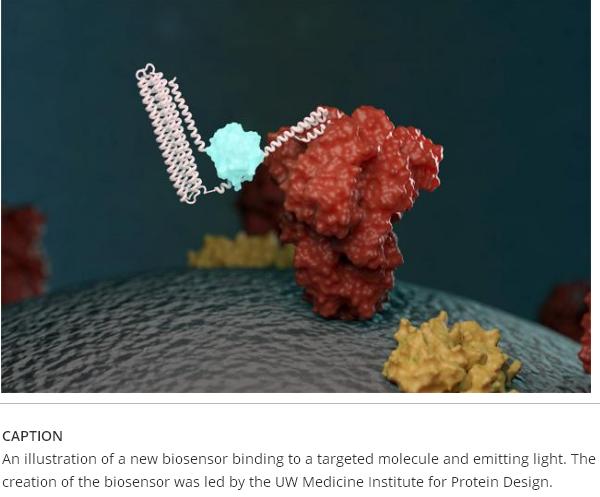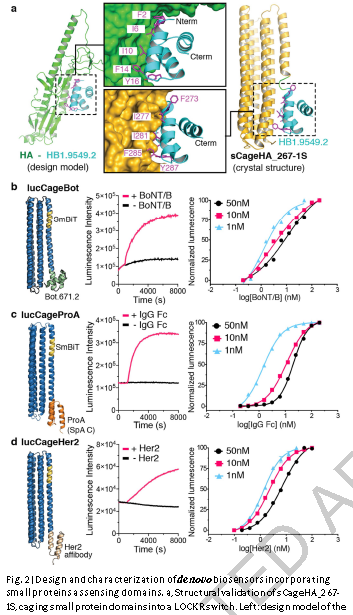博文
新型生物传感器:可快速检测冠状病毒蛋白和抗体(附原文)
 精选
精选
||
新型生物传感器:可快速检测冠状病毒蛋白和抗体(附原文)
诸平



据《华盛顿大学健康科学》(University of Washington Health Sciences)2021年1月29日的报道,由美韩研究人员组成的联合小组,合作开发出一种新型生物传感器,当与来自鼻拭子或血液样本的液体混合时,这些蛋白质传感器会在数分钟内发光。上述图像是新的生物传感器与目标分子结合并发光的示意图。生物传感器的创建是由华盛顿大学(University of Washington)医学院蛋白质设计研究所领导的。相关研究结果于2021年1月27日已经在《自然》(Nature)上发表——Alfredo Quijano-Rubio, Hsien-Wei Yeh, Jooyoung Park, Hansol Lee, Robert A. Langan, Scott E. Boyken, Marc J. Lajoie, Longxing Cao, Cameron M. Chow, Marcos C. Miranda, Jimin Wi, Hyo Jeong Hong, Lance Stewart, Byung-Ha Oh, David Baker. De novo design of modular and tunable protein biosensors. Nature (2021). Published: 27 January 2021. https://doi.org/10.1038/s41586-021-03258-z. s41586-021-03258-z_reference.pdf 参与该研究的除了来自美国华盛顿大学的科学家,还有来自韩国韩国高等科学技术学院(Korea Advanced Institute of Science and Technology)和韩国江原国立大学(Kangwon National University)的科学家。
他们创造了一种新的方法来检测构成大流行冠状病毒的蛋白质以及针对大流行冠状病毒的抗体。他们设计了基于蛋白质的生物传感器,当与病毒成分或特定的COVID-19抗体混合时会发光。这一突破可以在不久的将来实现更快、更广泛的测试。
目前,要诊断冠病毒感染,大多数医学实验室都依赖一种称为RT-PCR的技术,该技术可放大病毒的遗传物质,以便可以看到它;但是,此技术需要专门的人员和设备。它还消耗了全球范围内需求旺盛的实验室用品。供应链短缺使美国及其他地区的COVID-19测试结果放慢了速度。
为了直接检测患者样本中的冠状病毒而不需要进行基因扩增,由生物化学教授、华盛顿大学医学院蛋白质设计研究所(Institute for Protein Design at UW Medicine)所长戴维·贝克(David Baker)带领的一组研究人员使用计算机来设计新的生物传感器。这些基于蛋白质的设备识别病毒表面上的特定分子,与它们结合,然后通过生化反应发光。
抗体测试可以揭示一个人过去是否患有过COVID-19。它被用来追踪新冠疫情大流行的蔓延,但是它也需要复杂的实验室用品和设备。
华盛顿大学的同一研究小组还创造了与COVID-19抗体混合后会发光的生物传感器。他们表明,这些传感器对可能也存在于血液中的其他抗体(包括针对其他病毒的抗体)不产生反应,这种敏感性对于避免假阳性测试结果很重要。
戴维·贝克说:“我们已经在实验室中证明了这些新型传感器可以很容易地检测到模拟的鼻液或捐献的血清中的病毒蛋白或抗体。我们的下一个目标是确保将它们可靠地用于诊断环境。这项工作说明了从头进行蛋白质设计的能力,可以从头开始创建具有新的有用功能的分子装置。”
除COVID-19以外,联合研究小组还表明,可以设计类似的生物传感器来检测医学上相关的人类蛋白质,例如Her2(某些类型乳腺癌的生物标志物和治疗靶标)和Bcl-2(对淋巴瘤和某些癌症具有临床意义),其他癌症以及针对乙肝病毒的细菌毒素和抗体等。更多信息请注意浏览原文
s41586-021-03258-z_reference.pdf 或者相关报道。
Abstract
Naturally occurring protein switches have been repurposed for developing novel biosensors and reporters for cellular and clinical applications1, but the number of such switches is limited, and engineering them is often challenging as each is different. Here, we show that a very general class of protein-based biosensors can be created by inverting the flow of information through de novo designed protein switches in which binding of a peptide key triggers biological outputs of interest2. The designed sensors are modular molecular devices with a closed dark state and an open luminescent state; binding of the analyte of interest drives switching from the closed to the open state. Because the sensor is based purely on thermodynamic coupling of analyte binding to sensor activation, only one target binding domain is required, which simplifies sensor design and allows direct readout in solution. We demonstrate the modularity of this platform by creating biosensors that, with little optimization, sensitively detect the anti-apoptosis protein Bcl-2, the IgG1 Fc domain, the Her2 receptor, and Botulinum neurotoxin B, as well as biosensors for cardiac Troponin I and an anti-Hepatitis B virus (HBV) antibody that achieve the sub-nanomolar sensitivity necessary to detect clinically relevant concentrations of these molecules. Given the current need for diagnostic tools for tracking COVID-193, we used the approach to design sensors of antibodies against SARS-CoV-2 protein epitopes and of the receptor-binding domain (RBD) of the SARS-CoV-2 Spike protein. The latter, which incorporates a de novo designed RBD binder4, has a limit of detection of 15 pM and a signal over background of over 50-fold. The modularity and sensitivity of the platform should enable the rapid construction of sensors for a wide range of analytes and highlights the power of de novo protein design to create multi-state protein systems with new and useful functions.
https://blog.sciencenet.cn/blog-212210-1269786.html
上一篇:可生物降解显示器
下一篇:[转载]人教社中学数学编辑室的回复缺乏说服力